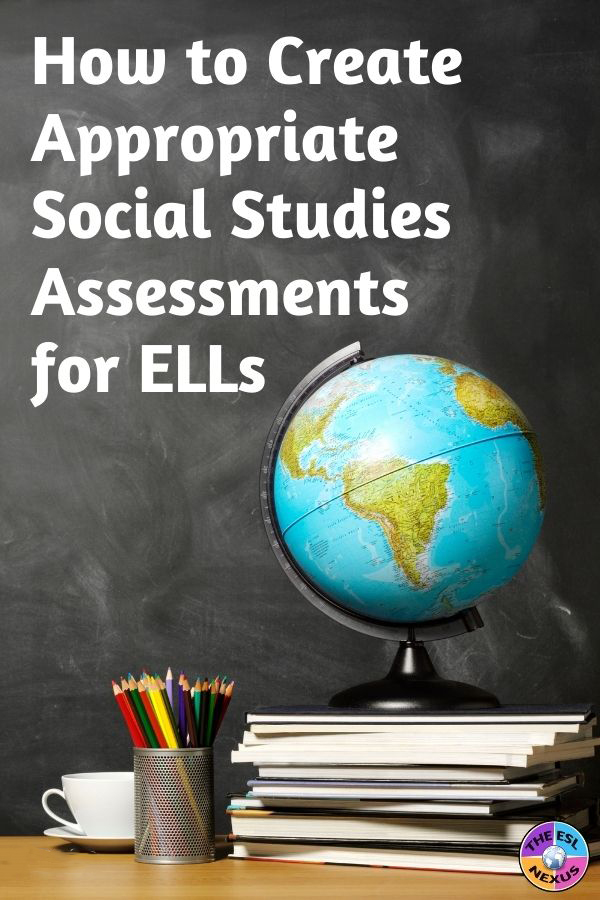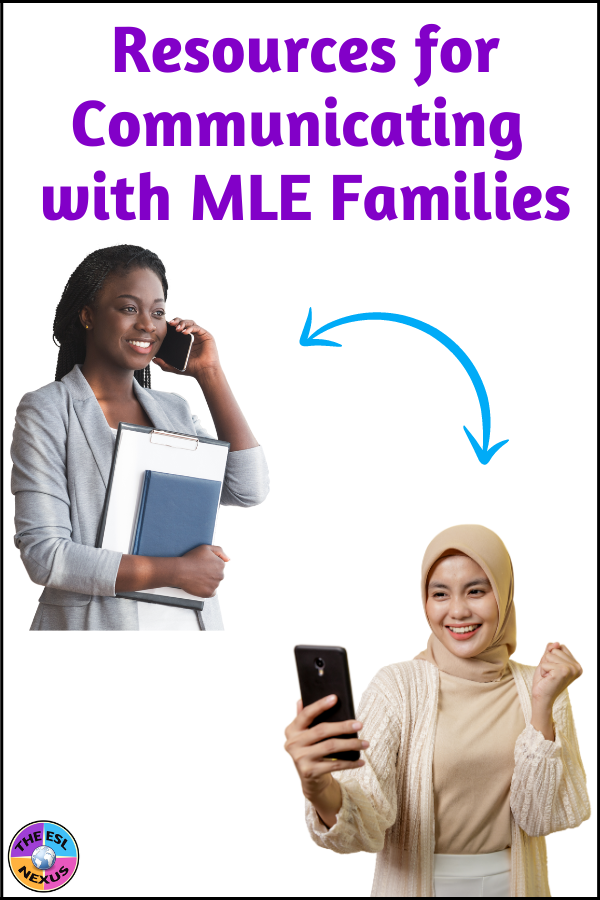Teaching Social Studies to English Language Learners (aka Multilingual Learners of English) who are in mainstream regular education classes can be challenging and designing ELL Social Studies assessments that appropriately evaluate what those students have learned may be even more difficult. In this blog post, I’d like to share some ideas about best practices for ELL assessment in Social Studies classes. Ideas are divided into grade spans, with examples for different language proficiency levels.
 |
| Find useful Social Studies materials at The ESL Nexus; graphic created by The ESL Nexus |
Upper Elementary ELL Social Studies Assessments
Types of Assessments
* Students use pictures and maps from magazines or found online, or draw their own pictures and maps, to describe a place or culture and include images that represent the place’s resources, people, and contributions or other features that you give them; assess the work according to the accuracy of the information provided.
* Students orally describe a place or culture and include target vocabulary words that you give them; assess students based on the accuracy of the content, not the accuracy of the language used (in other words, it’s fine if they make grammatical errors when talking, because it’s not a language test).
* Students match visuals with vocabulary words on a teacher-created page with images on one side and target vocabulary words on the other side; ways to do that are by having students draw lines from one side to the other, writing the vocab words next to the images, or if you’ve given letters to each word or image, writing the letter of the word next to the correct image; assess students by checking that the words and images are correctly paired.
* Students to write reports or give multimedia presentations; create rubrics that assess both content information and organizational features but focus on evaluating the content more than their use of English.
Examples of Assessments for Different Proficiency Levels
Below are some examples for creating ESL Social Studies tests about regions of the United States, a topic commonly taught in upper elementary grades.
For Beginning ELLs
* Give students a paper with a map of the United States on it and the names of regions on one side. Depending on how you taught the info and whether you think you students are able to do the task, the map may be completely blank or it may have the regions outlined on it. Tell students to label the regions and if using a blank map, tell them to draw the approximate borders of the regions first.
* Give students a list of some target vocabulary words or important concepts that you’ve taught. Give them some time to look at the words or concepts – you may want to give the info to students the night before or allow 15-20 minutes in class so they can prepare – and then ask students one at a time to use those words to describe however many regions you want to know about. You’ll want to be someplace in your classroom where the student being assessed won’t be distracted and where the other students can’t overhear what’s being said. You can ask students to give as much detail as possible about one region they or you have selected or you can ask them to talk in more general terms about all the regions.
For Intermediate ELLs
* Have students create a travel brochure about either one region or all regions. Give students a template to use that includes space for a title and lines for subtitles. Also give students a word bank that includes the features to describe and vocabulary words to include.
* Tell students to compare and contrast 2 different regions and tell them to write about the similarities and differences between the climate, natural resources, geography, history, and culture of those regions. Give students a Venn diagram of T-chart to use as a graphic organizer. (My TPT product, Compare and Contrast Writing in Two Formats, can help with this.) Students at the lower end of intermediate proficiency would also benefit from having sentence starters or sentence frames to help them write.
For Advanced ELLs
* Tell students to research a region and then write a report about it. Provide information about how to do research and how to write a multi-paragraph report plus a bibliography. To guide students in their research, give them a list of features and vocabulary words to include in their reports.
* Tell students to research a region and then create a poster about it. Tell the students that their posters should include information based on research they do (and give them info on how to do research) and should include target vocabulary that you want them to demonstrate they understand. You can have students orally present their posters to their class or small groups if you want to give them practice doing that but unless you’ve also taught them how to give effective oral presentations, they should not be graded on how well they orally describe their work.
Middle School ELL Social Studies Assessments
Types of Assessments
* Students create a poster about an ancient civilization or time period in U.S. American history and include features and target vocabulary words; assess the poster on the accuracy of the content info and use of vocab words.
* Students give multimedia presentations about an aspect of an ancient civilization or an event that occurred in the time period the class is covering; you can give students choices about what kind of presentation they can do, such as a short video, an online poster, an oral presentation with props, etc. and tell them to include certain info about particular features and vocab words.
* Students can create detailed timelines about important events in a historical period; assess the work on the accuracy of the chronology.
* Students can write biographies of important people in the time period the class covers, after you show them what kind of information to include and give them time to research the people; assess the biographies on both the accuracy of info and how well the reports conform to the format you taught your students.
* Students can compare and contrast two civilizations or historical events using graphic organizers that you provide (e.g. a Venn diagram, T-chart, mind map or web), being sure to include information they’ve learned about when they occurred, people involved, locations, and other important details; assess the work on how accurate and complete the information is and also on some language features if you’ve gone over them in class already. (My TPT product, Compare and Contrast Writing in Two Formats, can help with this.)
* Students can create a 3-D model of something an ancient civilization or time period is famous for, such as a pyramid, helmet, or jewelry and, if you wish, they can also write a description about it using target vocab words; assess the object on how well it resembles the actual thing. A great source of ideas for these kinds of projects is the Step Into the Ancient World: The History Book Box, which includes books about 8 civilizations; I used ideas from these books when teaching Ancient History and World History classes to my students. (This is an affiliate link. That means that I make a small commission if you purchase the History Book Box but it’s at no additional cost to you. Thank you for your support!)
Examples of Assessments
Here’s how you can create a differentiated ESL Social Studies test about Ancient Greece.
For Beginning ELLs
* Have students create a poster using images found online or in magazines or which they draw themselves about 5 characteristics of Ancient Greece, such as city-states, famous people, styles of buildings, roles of women, rulers, natural resources/food, geography, religion, or wars and use target vocab words to caption their images; assess students on the accuracy of their work.
* Tell students to answer multiple-choice and true-false questions, and match vocabulary words with their definitions; include only 3 options for the multiple-choice questions, write the true-questions in simple English (so, no double negatives!), and include a word bank for the vocab section.
For Intermediate ELLs
* Give students 1-3 sentence-long descriptions in easy-to-understand language of events and tell them to put the events in the correct chronological order; you can list the events on one side of a page and put the years on the opposite side and have students draw lines to connect the correct years and events, or you can make task cards with the events and years on different cards and tell students to pair them up; assess students on whether they have correctly matched the events with the years.
* Tell students, after you’ve taught them how to do it, to research and write a report that is at least 1-page long about a famous historical figure, such as a ruler, playwright, philosopher, or scientist, and include at least 3 sources in a bibliography; assess the written work with a rubric you’ve shared with the class and which evaluates the quality of the content as well as language features that are used in biographies (such as writing events in chronological order).
For Advanced ELLs
* Tell students to research and then create a multimedia presentation about a particular feature of Ancient Greece which they present to the class such as architecture, religion, government, scientific achievements, or the arts; give students info about what to include in their presentation and how it will be graded when you explain what they have to do, then assess them according to those parameters.
* Tell students to compare and contrast the system of government in Ancient Greece with the type of government in another ancient civilization they have already learned about, and then write an essay describing the similarities and differences between the two, using sentence prompts or sentence starters to guide them; you could also tell students that after describing the two systems, they should write about which one they think is better and why; assess students with a rubric they’re familiar with that evaluates both content information and language used. (My TPT product, Opinion, Persuasive, and Argumentative Writing Resources, can help with this.)
High School ELL Social Studies Assessments
I have never taught high school Social Studies classes so I’m not going to include how to assess students in Grades 9-12. However, many of these Social Studies assessments for English Language Learners can also be used at the high school level. Just tailor them to your curricula and make them more rigorous by asking students to analyze events and include more higher level critical thinking in written reports, essays, and presentations. But you can evaluate the language aspects pretty much the same way for high schoolers as for elementary and middle school students at the various proficiency levels.
Conclusion
Although Social Studies requires students to read and understand a lot of material in English, it is definitely possible for you to assess English Language Learners who have different language proficiency levels in your classes. I hope this blog post has given you some ideas on how you can do that.
To learn about creating assessments for ELLs in English Language Arts classes, this blog post offers lots of information.




